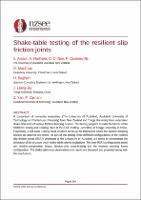| dc.contributor.author | Assadi, Soheil | |
| dc.contributor.author | Bagheri, Hamed | |
| dc.contributor.author | Yan, Zhenduo | |
| dc.contributor.author | Zarnani, Pouyan | |
| dc.contributor.author | Hashemi, Ashkan | |
| dc.contributor.author | MacCrae, Greg | |
| dc.contributor.author | Clifton, Charles | |
| dc.contributor.author | Jia, Liang-Jiu | |
| dc.contributor.author | Quenneville, Pierre | |
| dc.date.accessioned | 2024-07-01T02:01:08Z | |
| dc.date.available | 2024-07-01T02:01:08Z | |
| dc.date.issued | 2024-04-09 | |
| dc.identifier.uri | https://repo.nzsee.org.nz/xmlui/handle/nzsee/2677 | |
| dc.description.abstract | A consortium of university researchers (UoA, AUT and UC) from New Zealand and Tongji University have undertaken shake-table tests of various friction damping devices. This testing program is under the banner of the ROBUST Testing and is taking place at the ILEE Testing Laboratory at Tongji University in China. Essentially, a full-scale 3 storey steel structure serves as the framework where the seismic damping devices are attached and tested.
As part of this testing, three different configurations of the resilient slip friction joints (RSFJ) developed at the University of Auckland are tested to demonstrate the behaviour of the structure under shake-table seismic excitations. The three RSFJ configurations tested are: tension-compression braces, tension-only cross-bracing and the moment resisting frame configuration. The shake-table tests observations and results are discussed and presented along with the conclusions. | |
| dc.language.iso | en | |
| dc.publisher | New Zealand Society for Earthquake Engineering | |
| dc.relation.ispartofseries | 2024;164 | |
| dc.subject | Seismic performance, risk mitigation and resilience of new and existing structures | |
| dc.title | Shake-Table Testing of the Resilient Slip Friction Joints | |
| dc.type | Article | |

